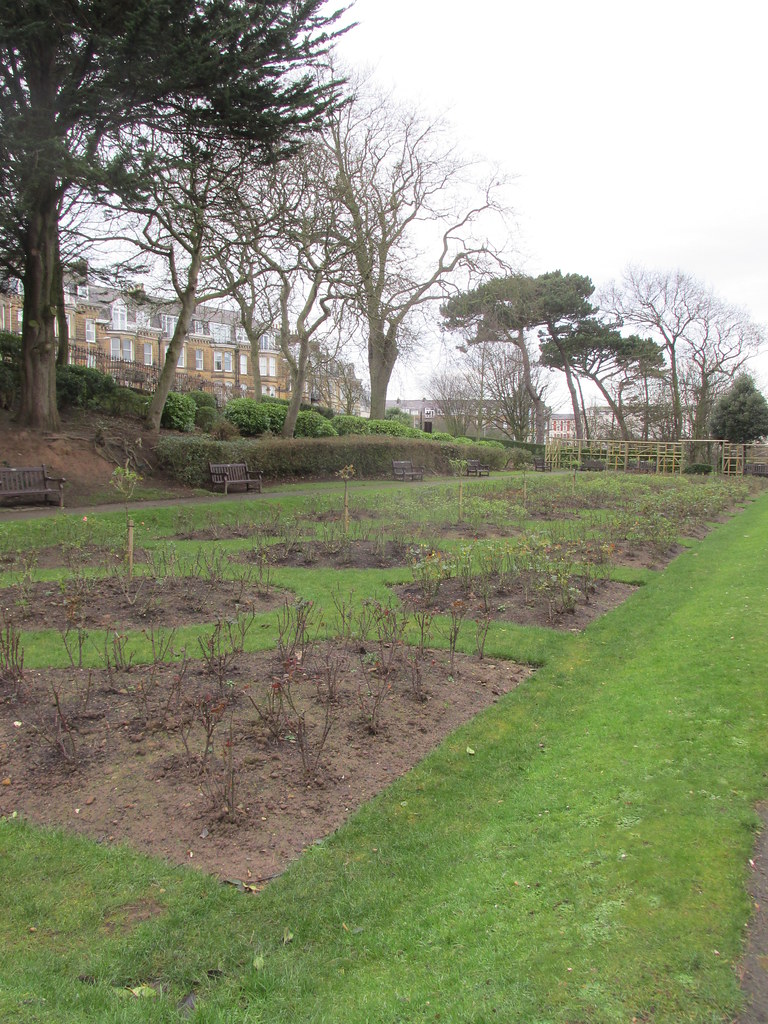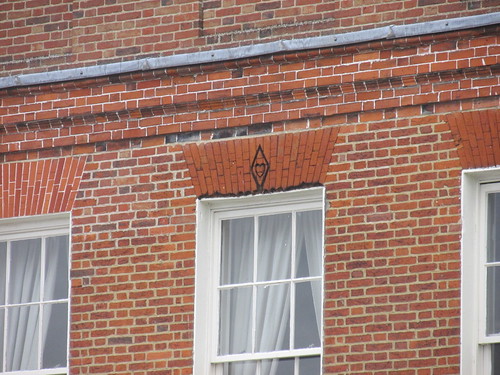In 1883 a wealthy art dealer from Scarborough created a rose garden in the town. George Lord Beeforth owned a large area of the South Cliff, and established the garden near his home on the Esplanade. The two were linked by a lighted subway that ran under the current road. More than 14,000 bushes were said to be planted in formal beds across the plot.
Beeforth sold most of his land to Scarborough Corporation in 1912, including the rose garden, and it was opened to the public.
Over the years the garden fell into poor condition. Part of the problem was the shade caused by trees originally planted to shelter the area from sea winds and spray. By 2013 the area was very badly deteriorated and the Friends of South Cliff Gardens applied for a Heritage Lottery Fund grant to restore it.
The work took 15 months, during which drainage was improved, trees were pruned, new topsoil was imported, and 1,100 new rose bushes were planted. The site was officially re-opened last June.
Of course, we visited in January, so we didn't see it at its best; though the lack of foliage meant it was possible to get a clear view of the bedding plan and the layout of the garden.
And more...
Saturday, 30 January 2016
Thursday, 28 January 2016
Comment moderation
Forgive me, readers, but I have introduced comment moderation for my own preservation.
Friday, 22 January 2016
Witch heart
As I promised I have just one more tale to tell you of Kings Lynn. One of the main squares in the town is the Tuesday Market Place (There's a Saturday Market Place too.) and the boundaries of the square feature some attractive old buildings. On the north side is a large red brick house with segmental arches above its windows. On the keystone above one window is a carved diamond with a heart at its centre. The mark is known as the witch's heart.
In 1590 townswoman Margaret Read was accused of witchcraft and sentenced to be burned at the stake in the public execution space at the Tuesday Market Place. She protested her innocence, but to no avail, and the execution was carried out as ordered by the court. She swore she would be avenged against her accusers, and on the morning of her death, just as the flames reached her chest, her heart burst through her ribs and marked the house of the Chief Magistrate who had condemned her.
There is, of course, one significant flaw in this story. Witches in Britain were rarely burned at the stake, in spite of all the stories you've been told. They were hanged.
In 1590 townswoman Margaret Read was accused of witchcraft and sentenced to be burned at the stake in the public execution space at the Tuesday Market Place. She protested her innocence, but to no avail, and the execution was carried out as ordered by the court. She swore she would be avenged against her accusers, and on the morning of her death, just as the flames reached her chest, her heart burst through her ribs and marked the house of the Chief Magistrate who had condemned her.
There is, of course, one significant flaw in this story. Witches in Britain were rarely burned at the stake, in spite of all the stories you've been told. They were hanged.
Sunday, 17 January 2016
Hanseatic
The town of Kings Lynn in Norfolk was part of the Hanseatic League, a powerful association of merchants from Northern Germany, the Baltic countries, and those around the North Sea, which operated from the 14th to the early 19th century. By belonging to a trade association such as the League, merchants benefited greatly. It protected economic interests and offered diplomatic privileges to its members.
It is believed to have its early origins in the German town of Lübeck, which was captured by Henry, Duke of Saxony in 1158. Under his rule the town quickly gained dominance of the international trade around the Baltic and became a centre for merchants from around the area. The area's economic strength was built on products such as wax, amber, resin, furs and timber. The League was officially launched in 1356. Towns in the league raised their own armies and were required to come to each other's aid in times of threat.
In spite of the extent of the Hanseatic League at its height (including Bristol, Boston Lincolnshire, Hull, Ipswich, Norwich and Yarmouth) there is only one remaining original Hanseatic warehouse in Europe, and that's in King's Lynn. Walking around the old town it's not difficult to imagine what the port was like in its heyday.
I was lucky enough to live in Kings Lynn old town some years ago. Very close to where these photos were taken - even closer to the photo in my previous post. There's much more to the town than I've told you about here, but I'm not going to bore you with it all. There's just one more story to tell you. Watch this space.
 |
| Part of the old town |
 |
| Kings Lynn's Hanseatic Warehouse |
I was lucky enough to live in Kings Lynn old town some years ago. Very close to where these photos were taken - even closer to the photo in my previous post. There's much more to the town than I've told you about here, but I'm not going to bore you with it all. There's just one more story to tell you. Watch this space.
Monday, 11 January 2016
Captain Vancouver
 |
| Captain Vancouver on Purfleet Quay, Kings Lynn |
As well as naming the Canadian city of Vancouver after himself, he gave other landmarks names of his crew, including Mount Baker, Puget Sound, Mount Hood and Mount Rainier.
However, his travels did not make him popular with everyone. Crewman Thomas Pitt, 2nd Baron Camelford took offence after being disciplined for various infractions of Navy rules. When he returned home he persuaded his cousin William - who just happened to be Prime Minister - to help him bring Vancouver into dishonour. But Prime Minister Pitt (the younger) did not succeed fast enough for sailor Pitt, who challenged his former captain to a duel.
Vancouver refused to take part in a dual to answer for his actions as a serving naval officer so Pitt eventually attacked him in the street. Both were accompanied by friends and an unseemly brawl ensued, which led to a fight in the press, as both sides accused the other of being the instigator, among other crimes. The stress proved too much for Vancouver, who died aged only 40, worn out from his naval service and the legal battles.
Wednesday, 6 January 2016
More Swaffham
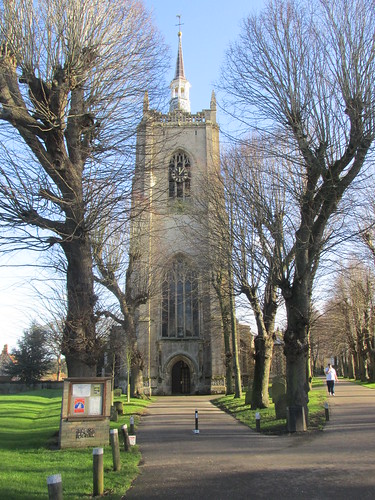 |
| Swaffham Church |
There has been a church on the site since the 12th century, but as the pedlar tale tells, it was rebuilt in 1454. It is acknowledged as one of the finest medieval churches in Norfolk.
The church is built from Barnack stone, a type of limestone quarried near Stamford in Lincolnshire.
 |
| The hammer beam roof |
The exterior of the church features a magnificent stone frieze with roundels, some containing the crossed keys of St Peter and others with the crossed swords of St Paul.
The tower, with its ring of eight bells, has a very impressive fleche (arrow) spire.
Saturday, 2 January 2016
The pedlar of Swaffham
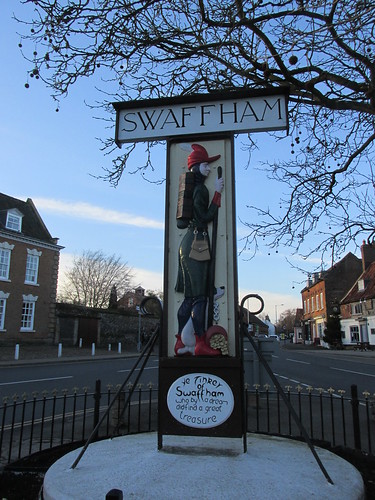 |
| The village sign |
The story goes that many years ago a pedlar from the Norfolk market town of Swaffham dreamed that he should travel to London where a man on London Bridge would tell him where to find a buried treasure. The pedlar's name was John Chapman (an old word for pedlar) and he told his family of his dream but they laughed and said he would be wasting his time. But Chapman ignored them and, taking his dog and his pack, set off for the capital.
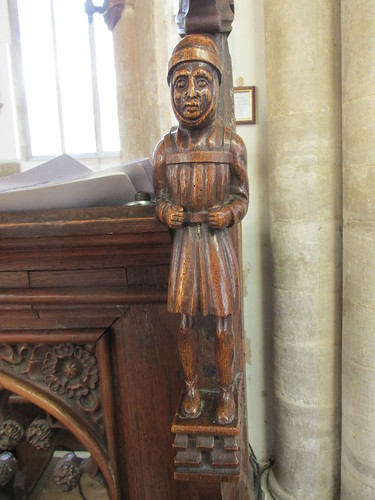 |
| 15th century original |
He told no-one of his find, and placed the pot among the others in his home. The surface was decorated and had a Latin inscription around it, but the pedlar could not read Latin. Then one day a monk on his way to a pilgrimage in Walsingham told Chapman what it said. The inscription translated as "Where you find me, dig to find another." So Chapman went back into his garden and dug in the same spot, where he found an even bigger pot full of gold coins.
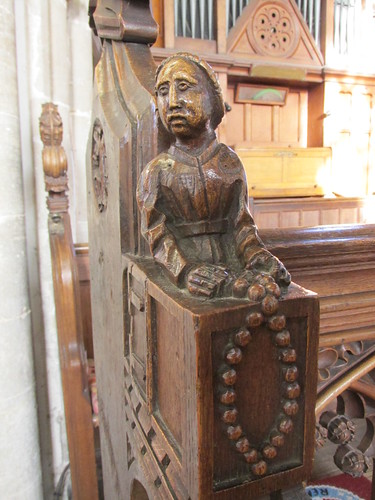 |
| Chapman's wife |
Enough money was left over to build the tower and spire.
And now the facts:
There really was a churchwarden called John Chapman who paid a great deal of money towards the church restoration in 1460. Contemporaneous carvings of a pedlar carrying a pack, a dog, and a woman using rosary beads are currently incorporated into the clergy stalls. They are believed to be from the original Chapman family pew. When the Victorians replaced the old-fashioned box pews they put a replica carving of the pedlar on the front row of the new seating.
Subscribe to:
Posts (Atom)

